James Redford is a climate activist and filmmaker. He is co-founder and chair of the Redford Center. Adam Browning is executive director of Vote Solar, a nonprofit organization working to expand solar access in states nationwide.
During our recent travels across the United States, we met with the policymakers, business leaders and activists behind the nation’s radical shift to clean energy. After speaking with them, it became evident that there were countless motivations driving this transition: climate change, healthier air, environmental justice, customer choice, national security and energy freedom. But no matter whom we talked to, there was one universal driver that transcended position and political affiliation — and that’s pure economics.
A recent report projected that by 2050, wind and solar will produce 50 percent of the world’s electricity just from the gravitational pull of cost-competitiveness. Over the past 10 years or so, the cost of solar power in the United States has declined 86 percent and wind 67 percent. We are already seeing businesses and municipalities signing solar power contracts and investing in wind mills or solar farms instead of natural gas plants based purely on cheap prices. Furthermore, the latest breakthroughs in energy storage technologies are beginning to hit the market, allowing us to keep the lights on even when the wind doesn’t blow or the sun doesn’t shine.
As a result of falling prices and better technology, clean energy is being rapidly adopted. The five largest publicly-traded companies in the world — Apple, Amazon, Google’s Alphabet, Microsoft and Facebook — all have corporate commitments to use 100 percent renewable energy and at least three of them have already hit those ambitious targets. The eighth largest, Berkshire-Hathaway, owns one of the country’s largest utility wind and solar portfolios and is aggressively developing more renewable energy projects.
By 2020, MidAmerican Energy Company, an Iowa-based Berkshire-Hathaway subsidiary, aims to become the nation’s first investor-owned utility to produce enough renewable energy to cover 100 percent of its customers’ electricity needs. CEO Adam Wright called the target a win-win because the utility has “been able to invest in renewables while at the same time keeping electric rates affordable for the long term.”
And it’s not just massive corporations looking out for their bottom lines. Families, churches, schools and entire communities are increasingly turning to affordable rooftop solar panels and other clean energy options to better manage their electricity bills.
In addition to keeping electricity costs low, all of that clean energy investment is putting money back into our local economies. In Minnesota, Governor Mark Dayton’s administration realized that the $18 billion the state was spending every year to import fossil fuels would be better spent investing in infrastructure and jobs right at home. Today, 57,000 Minnesotans work in the state’s growing new energy economy, powered in large part by a pioneering community solar program.
While there are about 50,000 who work in the coal mining industry in the United States, 349,000 Americans get their paycheck from a solar-related business. A higher percentage than the general economy, about 9 percent of this expanding solar energy workforce is made up of veterans, who are continuing to serve our country by decreasing our dependence on fossil fuels and making our power grid more secure. Many in this workforce whom we talked to are those who lost their jobs in the Great Recession or who live in communities where economic opportunity had been scarce even before the economic downturn.
Recognizing that it’s the right thing to do — both for their local economies and for the world we’re leaving to our children — U.S. states are now leading the charge on clean energy. Already this year, New Jersey voted to establish a target of 50 percent by 2030. Colorado regulators approved a plan from the state’s largest utility to move to 55 percent renewable energy by 2026. California, the world’s fifth largest economy, just joined Hawaii in making an impressive commitment to 100 percent clean power by 2045. Florida’s solar development soared to make it the nation’s second biggest growth market in the first quarter of this year. In fact, six of the top 10 solar growth markets were states that have Republican governors. Texas has continued to dominate the U.S. wind market.
Reflecting on the many different people and places of America’s clean energy success story, two things are clear. First, that our love of homegrown renewable energy is one thing that unites this divided country. And second, despite headwinds from Washington, states can and will power our country with clean energy.
This was produced by The WorldPost, a partnership of the Berggruen Institute and The Washington Post.





